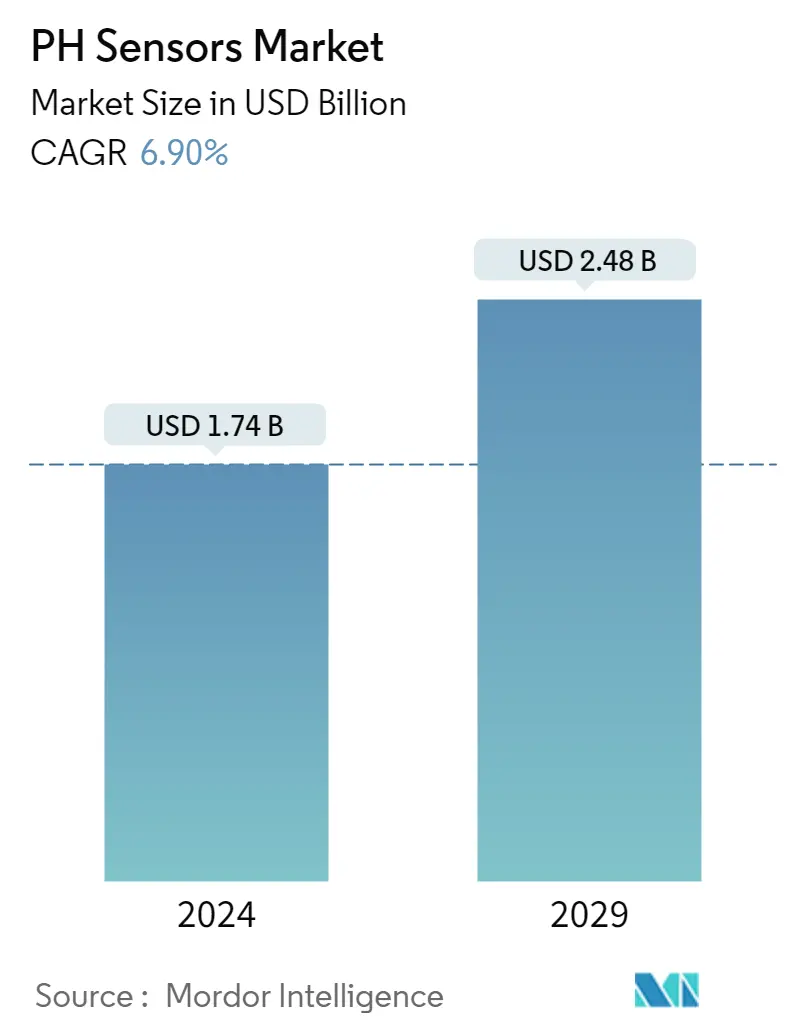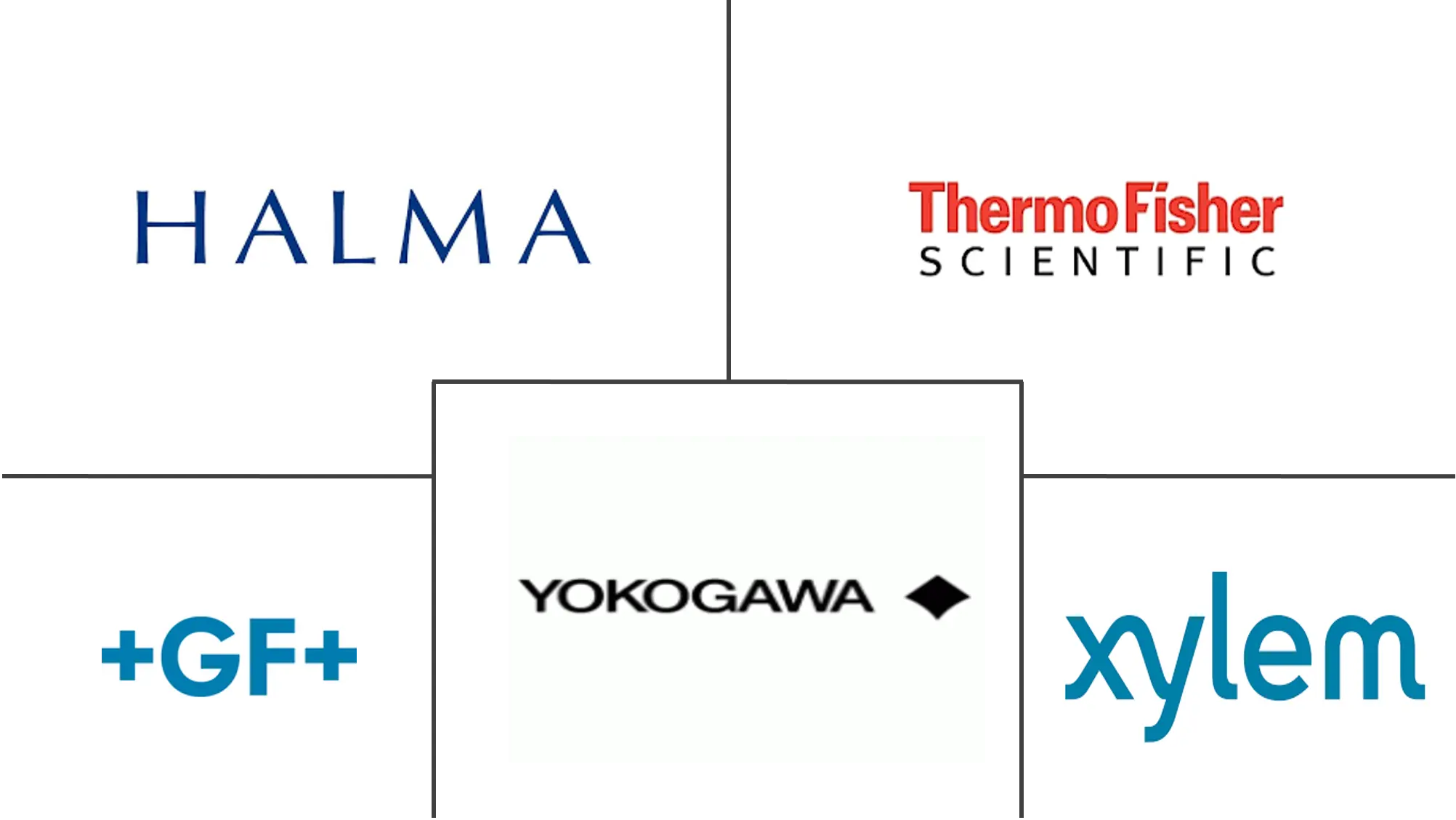Market Size of PH Sensors Industry

| Study Period | 2019 - 2029 |
| Market Size (2024) | USD 1.74 Billion |
| Market Size (2029) | USD 2.48 Billion |
| CAGR (2024 - 2029) | 6.90 % |
| Fastest Growing Market | Asia Pacific |
| Largest Market | North America |
Major Players
*Disclaimer: Major Players sorted in no particular order |
pH Sensors Market Analysis
The PH Sensors Market size is estimated at USD 1.74 billion in 2024, and is expected to reach USD 2.48 billion by 2029, growing at a CAGR of 6.90% during the forecast period (2024-2029).
The market growth is driven by the surge in the usage of pH sensors and analyzers in water, wastewater, chromium, and aquaculture treatment plants for formulating precise readings of the oxidation-reduction potential and pH levels. pH sensors monitor drug efficiency and provide optimal pH levels for pharmaceutical manufacturing, further driving the market.
- Further, the growth in the need for industrial automation around the globe is one of the essential elements driving the development of the pH sensors market. Additionally, the government of India sanctioned a PLI scheme for 16 plants for critical starting materials (KSM)/drug intermediates and functional pharmaceutical ingredients (APIs). Installing these 16 plants would result in a total investment of USD 47.01 million. The commercial development of these plants is anticipated to begin by April 2023. Furthermore, the government lately allocated USD 362.32 million to upgrade electronics and IT hardware manufacturing and USD 104.25 million for the Faster Adoption & Manufacturing of Hybrid and Electric automobiles in India (FAME - India).
- ZVEI (German Electrical and Electronic Manufacturers' Association) specified that these circumstances created a favorable business environment for the measurement and process automation industry while raising the need for process analytics instruments, such as pH sensors and analyzers.
- In addition, Stringent government rules over industrial and municipal wastewater disposal are driving the water treatment technology need evolution in recycling and reuse systems which may provide further momentum to create the market studied during the forecast period.
- Furthermore, Municipal authorities widely use wastewater technology in different cities across India for municipal wastewater treatment. According to NITI Aayog, India's market for wastewater treatment plants is expected to rise to USD 4.3 billion by 2025 due to growing demand for municipal and sewage water therapy facilities nationwide.
- Further, countries worldwide have made considerable investments in water infrastructure and desalination projects. For instance, the central government in Chile plans to fund USD 280 million in water infrastructure over the coming years. Countries have also developed to present incentives to promote water and wastewater treatment around the globe, which is anticipated to push the market for pH sensors & analyzers market.
- However, cost constraints and a need for established standards restrain market growth. Many pH sensors, like combination, differential, laboratory, and process pH sensors, are utilized and notice high commercial acceptance. However, there are only so many specified standards for their operation. These technologies are different from each other and lack compatibility. Lack of awareness, less acceptability, and the unjust quality standard these sensors offer could also hinder the market growth.
pH Sensors Industry Segmentation
The pH sensor is essential for measuring pH and is majorly used in water quality monitoring. This type of sensor can calculate alkalinity and acidity in water and other solutions. When appropriately operated, pH sensors can provide the safety & quality of products and processes in wastewater, manufacturing plants, and other verticals.
The pH Sensors market is segmented by t ype (benchtop analyzers, portable analyzers, process analyzers), application (water and wastewater, oil and gas, medical, food and beverages, industrial), and geography (North America, Europe, Asia Pacific, Latin America and Middle East & Africa). The market sizes and forecasts are provided in terms of value (USD) for all the above segments.
| By Type | |
| Benchtop Analyzers | |
| Portable Analyzers | |
| Process Analyzers |
| By Application | |
| Water and Wastewater | |
| Medical | |
| Oil and Gas | |
| Food and Beverages | |
| Industrial | |
| Other Applications |
| By Geography*** | |
| North America | |
| Europe | |
| Asia | |
| Australia and New Zealand | |
| Latin America | |
| Middle East & Africa |
PH Sensors Market Size Summary
The pH sensors market is poised for significant growth, driven by increasing applications in water and wastewater treatment, pharmaceutical manufacturing, and industrial automation. The demand for precise pH and oxidation-reduction potential measurements is crucial in sectors such as aquaculture and chromium wastewater treatment, which are heavily regulated by environmental agencies. The market is further bolstered by government initiatives and investments in water infrastructure and desalination projects worldwide, particularly in regions like Asia-Pacific, North America, and Europe. These developments are creating a favorable business environment for pH sensors and analyzers, as they are essential for ensuring compliance with stringent environmental regulations and optimizing industrial processes.
Despite the promising growth prospects, the market faces challenges such as cost constraints, lack of established standards, and limited awareness of pH sensor technologies. However, the presence of major players like Halma PLC, Thermo Fisher Scientific Inc., and Xylem Inc. is helping to drive innovation and expand market reach through strategic collaborations and acquisitions. Recent advancements, such as the development of low-cost and highly accurate pH sensors, are expected to enhance product capabilities and increase adoption across various industries. As investments in water treatment and infrastructure projects continue to rise, the pH sensors market is anticipated to experience robust growth, with significant opportunities emerging in emerging economies and technologically advanced regions.
PH Sensors Market Size - Table of Contents
-
1. MARKET INSIGHTS
-
1.1 Market Overview
-
1.2 Industry Value Chain Analysis
-
1.3 Industry Attractiveness- Porter's Five Forces Analysis
-
1.3.1 Bargaining Power of Suppliers
-
1.3.2 Bargaining Power of Buyers
-
1.3.3 Threat of New Entrants
-
1.3.4 Threat of Substitute Products
-
1.3.5 Intensity of Competitive Rivalry
-
-
-
2. MARKET SEGMENTATION
-
2.1 By Type
-
2.1.1 Benchtop Analyzers
-
2.1.2 Portable Analyzers
-
2.1.3 Process Analyzers
-
-
2.2 By Application
-
2.2.1 Water and Wastewater
-
2.2.2 Medical
-
2.2.3 Oil and Gas
-
2.2.4 Food and Beverages
-
2.2.5 Industrial
-
2.2.6 Other Applications
-
-
2.3 By Geography***
-
2.3.1 North America
-
2.3.2 Europe
-
2.3.3 Asia
-
2.3.4 Australia and New Zealand
-
2.3.5 Latin America
-
2.3.6 Middle East & Africa
-
-
PH Sensors Market Size FAQs
How big is the PH Sensors Market?
The PH Sensors Market size is expected to reach USD 1.74 billion in 2024 and grow at a CAGR of 6.90% to reach USD 2.48 billion by 2029.
What is the current PH Sensors Market size?
In 2024, the PH Sensors Market size is expected to reach USD 1.74 billion.

